The Charles Bridge: A Historic Landmark in Prague
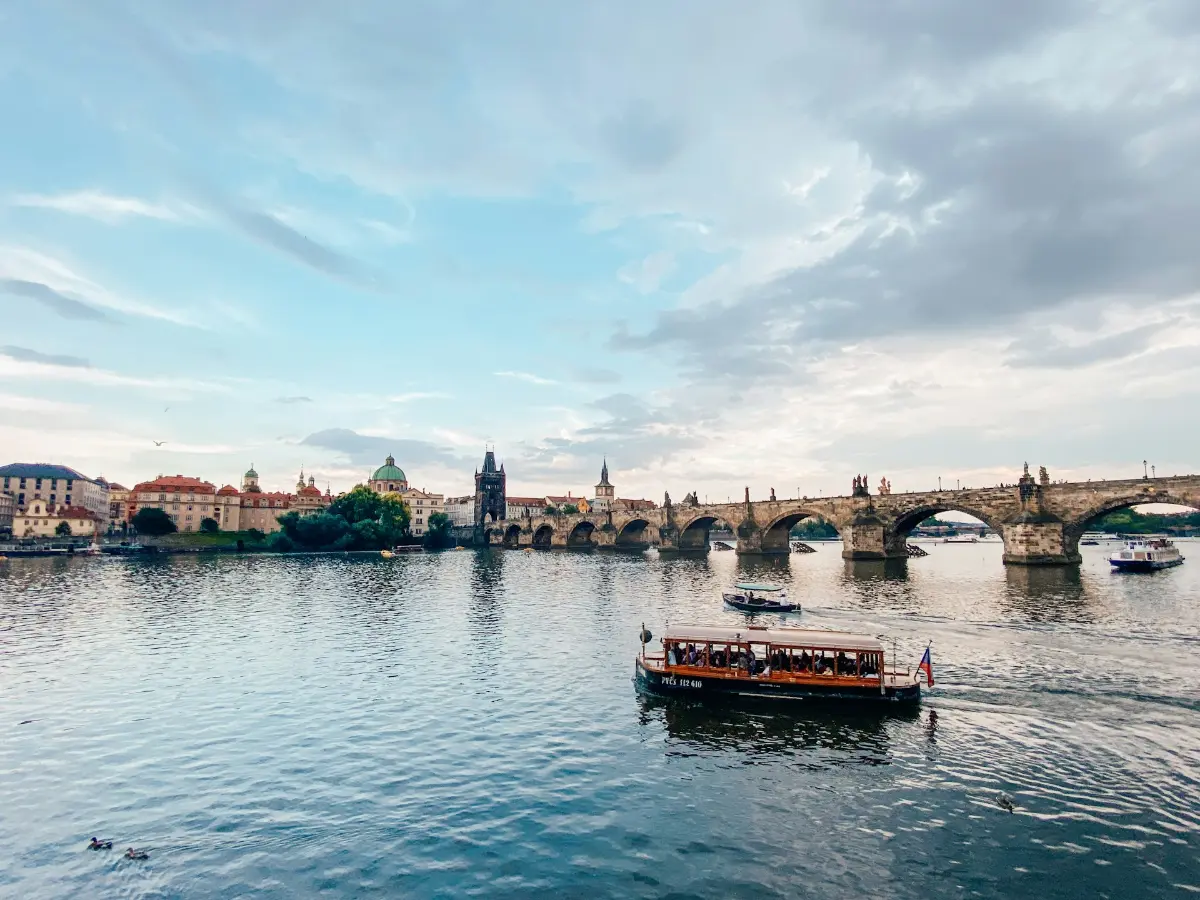
The Charles Bridge is a medieval stone arch bridge that crosses the Vltava River in Prague, Czech Republic. It is one of the most iconic landmarks in the city and a popular destination for tourists from all over the world. The bridge was constructed six centuries ago and has become essential to the city’s history and culture.
The construction of the Charles Bridge began in 1357 under the auspices of King Charles IV, and it was completed in the early 15th century.
The bridge replaced the Judith Bridge, which had been unable to withstand a flood in 1342. The Charles Bridge has since been an essential part of Prague’s history, as it was the only crossing over the Vltava for centuries.
Today, the Charles Bridge is a popular destination for tourists to admire its stunning views of the Vltava River and the city of Prague. The bridge features centuries of fascinating history, and visitors can learn about its architecture, legend, and significance to the city’s culture and history.
Architectural Evolution

Tourists explore iconic Charles Bridge, ©Kováčová / Pexels
You are standing on the Charles Bridge, one of Prague’s most iconic landmarks. This historical bridge stretches over the Vltava River, connecting the Old Town with the Lesser Town.
The Charles Bridge was built between 1357 and 1402 under the auspices of King Charles IV, the Holy Roman Emperor. The bridge replaced the old Judith Bridge, which was destroyed by floods.
The construction of the Charles Bridge was a significant event in the history of Prague and Bohemia. King Charles IV wanted to create a grand symbol of his power and wealth, and the bridge was one of his most ambitious projects. The bridge was built by the best architects and engineers of the time, adorned with many statues and decorations.
The Charles Bridge played an essential role in the history of Prague. During the Battle of White Mountain in 1620, the bridge was captured by the Imperial troops, and many of the Protestant leaders were executed on the bridge.
During the Thirty Years’ War, the Swedish army damaged the bridge. In the 18th and 19th centuries, the bridge became a popular site for painters and artists.
The Charles Bridge survived many historical events, including the Revolutionary Days in 1848 and World War II. Today, the bridge is a popular tourist attraction, visited by millions yearly.
The bridge offers stunning views of Prague’s skyline and the Vltava River. The bridge is also home to many street performers, musicians, and artists, adding to the city’s vibrant atmosphere.
Iconic Design
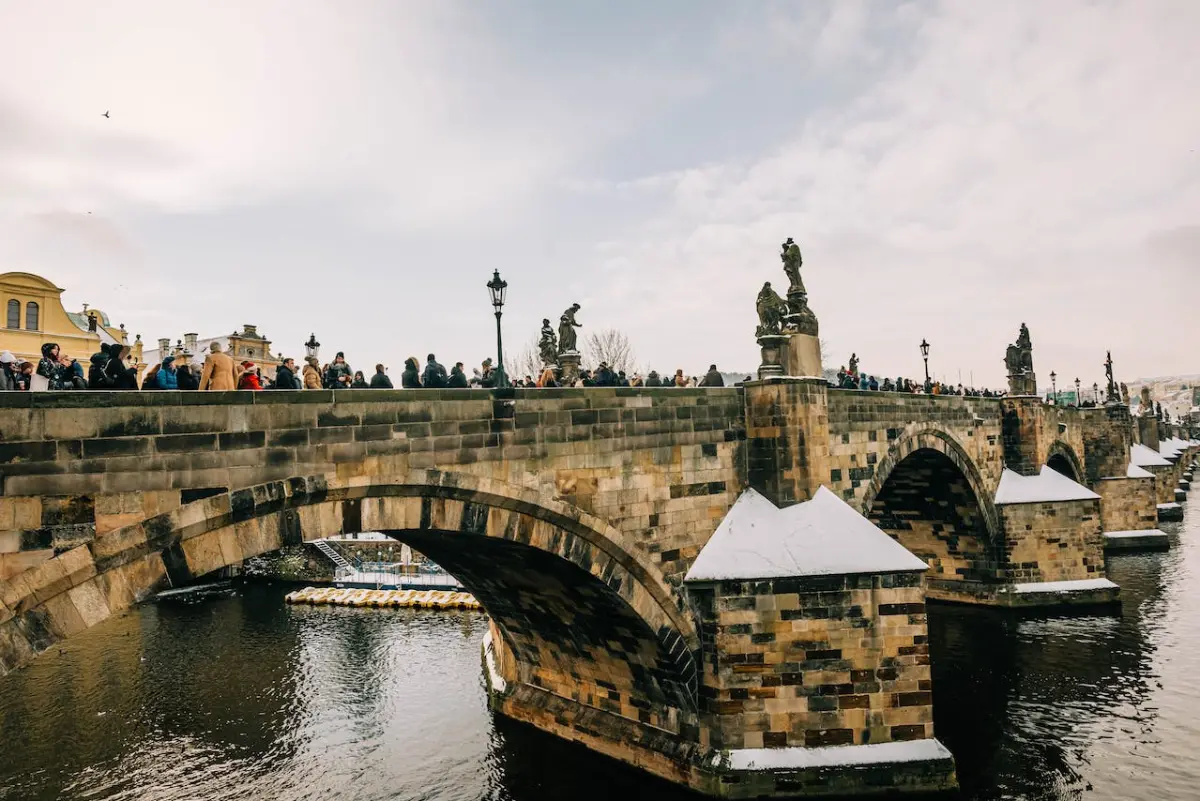
Amid winter’s grace, tourists cross Charles Bridge over the tranquil Vltava River, ©Kováčová / Pexels
The Charles Bridge is a stunning masterpiece of medieval Gothic architecture that spans the Vltava River in the heart of Prague. It is a stone arch bridge that connects the Old Town with Prague Castle and is one of the most recognizable landmarks in the city.
The bridge is made up of sandstone blocks and has a length of 621 meters. It features 16 arches and is supported by 15 pillars adorned with beautiful statues of saints.
The Charles Bridge is also flanked by two imposing towers, the Lesser Town Bridge Tower and the Old Town Bridge Tower, both made of stone.
The construction of the Charles Bridge began in 1357 under the auspices of King Charles IV and was completed in the early 15th century. Petr Parléř, a famous architect responsible for constructing St. Vitus Cathedral, designed the Charles Bridge.
Charles Bridge is an impressive feat of engineering and a work of art. The bridge is adorned with 30 Baroque statues added in the 17th and 18th centuries. These statues depict various saints and historical figures, including St. John of Nepomuk, who is said to bring good luck to those who touch his statue.
Artistic Heritage of the Charles Bridge
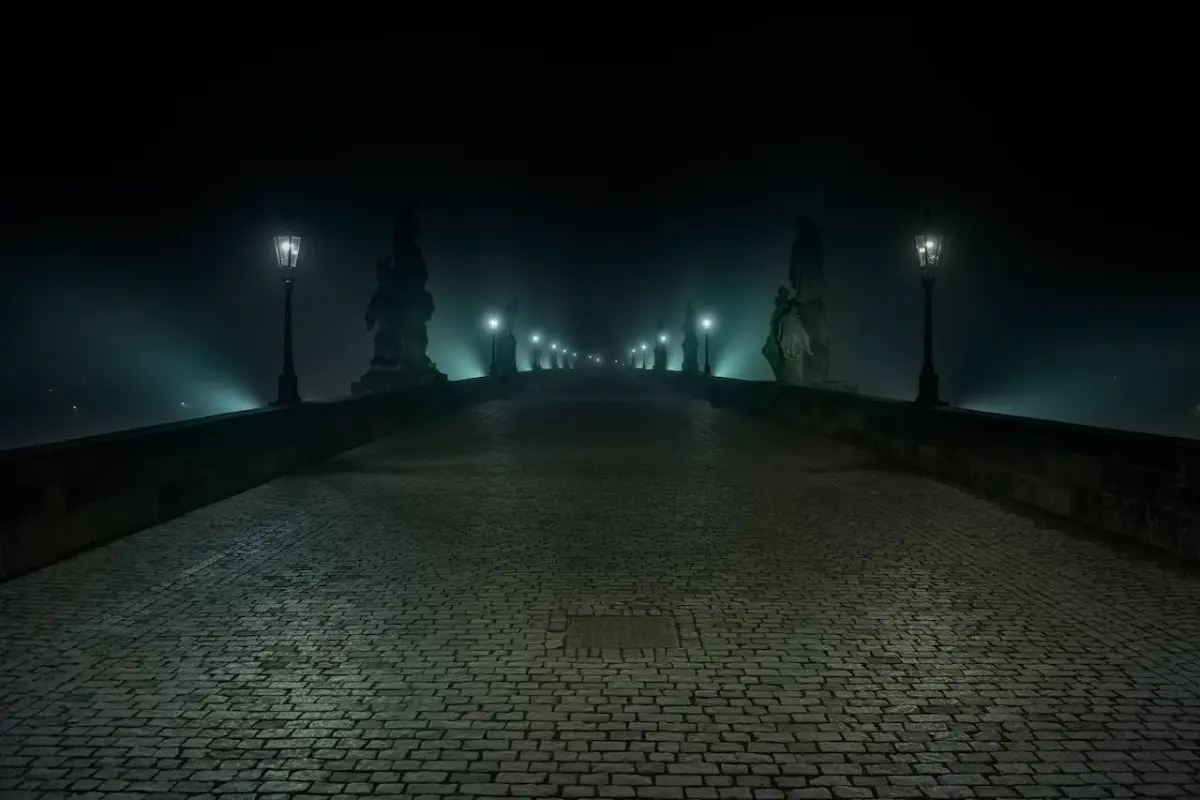
Silhouetted statues adorn Charles Bridge at night, ©svetjekolem / Pexels
As you stroll along the Charles Bridge, you will notice the thirty statues and sculptures that line the fence. These baroque-style statues were added in the early 1700s and are a significant attraction for tourists and locals alike.
Some of the most notable sculptures on the bridge include the statue of St. John of Nepomuk, the patron saint of Bohemia, who was thrown into the river from the bridge in the 14th century. Another famous sculpture is the Lamentation of Christ, which depicts Jesus on the cross and is located on the south side of the bridge.
Prominent sculptors created the statues, including Matthias Braun, Jan Brokoff, and his sons Michael Joseph and Ferdinand Maximilian. Braun’s St. Luthgard statue and Brokoff’s St. John of Nepomuk are some of the most impressive on the bridge.
Other notable sculptures include the statues of St. Vincent Ferrer and Procopius, St. Ivo, and Mary Magdalene. The Pseudo-Gothic statue of St. Joseph by Emanuel Max is also worth a mention.
Overall, the statues and sculptures on the Charles Bridge are a testament to the skill and artistry of the sculptors who created them. They are a beautiful and unique feature of this iconic landmark that you won’t want to miss.
Sustaining Legacy
The Charles Bridge has undergone several restorations and repairs to maintain its structural integrity. The most recent restoration project began in 2019 and is expected to last 20 years.
The project aims to fix the bridge’s ice guards and stone blocks. A committee of representatives from Prague City Tourism, the Municipal Department of Heritage Care, the Municipal Department of Property Management, and the National Heritage Institute will oversee the repairs.
The Charles Bridge has survived floods and fires over the past 650 years. The reconstruction of the bridge after the 1890 flood was a significant event in the bridge’s history, as it marked the beginning of the bridge’s transformation into a national monument. The bridge is made of Bohemian sandstone, known for its durability and resistance to weathering.
Overall, the restorations and repairs on the Charles Bridge are necessary to ensure its longevity and maintain its status as a cultural and historical landmark.
Location and Surroundings
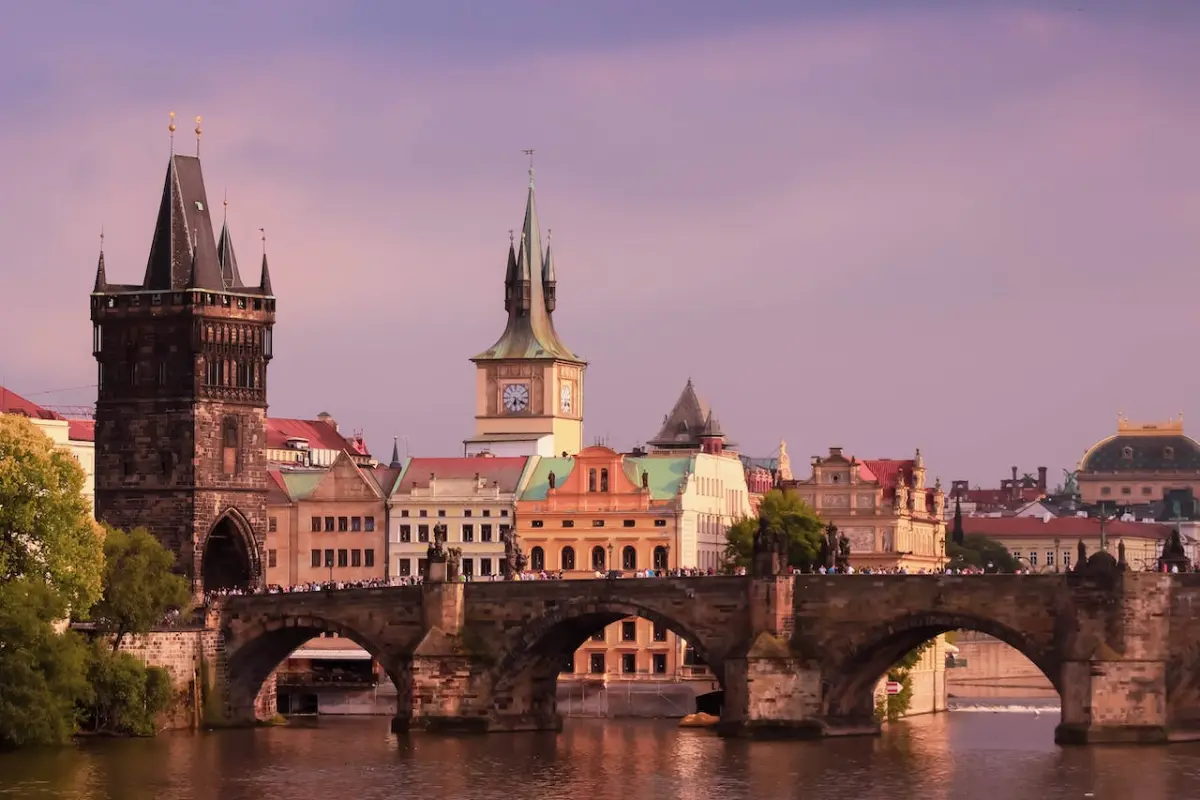
Iconic Charles Bridge spans Vltava River, ©Nair / Pexels
As you stand on the Charles Bridge, you can see the Vltava River flowing beneath you. The bridge is located in the heart of Prague, connecting the Old Town (Staré Město) with the Lesser Quarter (Malá Strana).
The Charles Bridge is a beautiful landmark and an important historical site. The bridge was commissioned by King Charles IV in 1357 to replace the Judith Bridge, which was destroyed by a flood in the late 12th century. The construction of the Charles Bridge was completed in the early 15th century and is considered a masterpiece of medieval architecture.
Several attractions surround the bridge, including the Old Town Bridge Tower, an excellent example of Gothic architecture. On the other side of the bridge, you will find the Lesser Quarter, home to the stunning Prague Castle. The castle is one of the most popular tourist destinations in the city and offers a breathtaking view of the city from its hilltop location.
Kampa Island is another popular attraction located near the Charles Bridge. The island is home to several museums, galleries, and cafes, making it an excellent spot to relax and enjoy the scenery. Additionally, the City of Prague Museum is located nearby, offering a fascinating insight into the city’s history.
Lastly, if you are looking for a night out, the Karlovy Lázně nightclub is near the bridge. It is the largest nightclub in Central Europe and offers several floors of music and dancing.
Overall, the Charles Bridge is a must-visit destination in Prague, offering a stunning view of the Vltava River and surrounded by several historical and cultural attractions.
Visiting the Charles Bridge
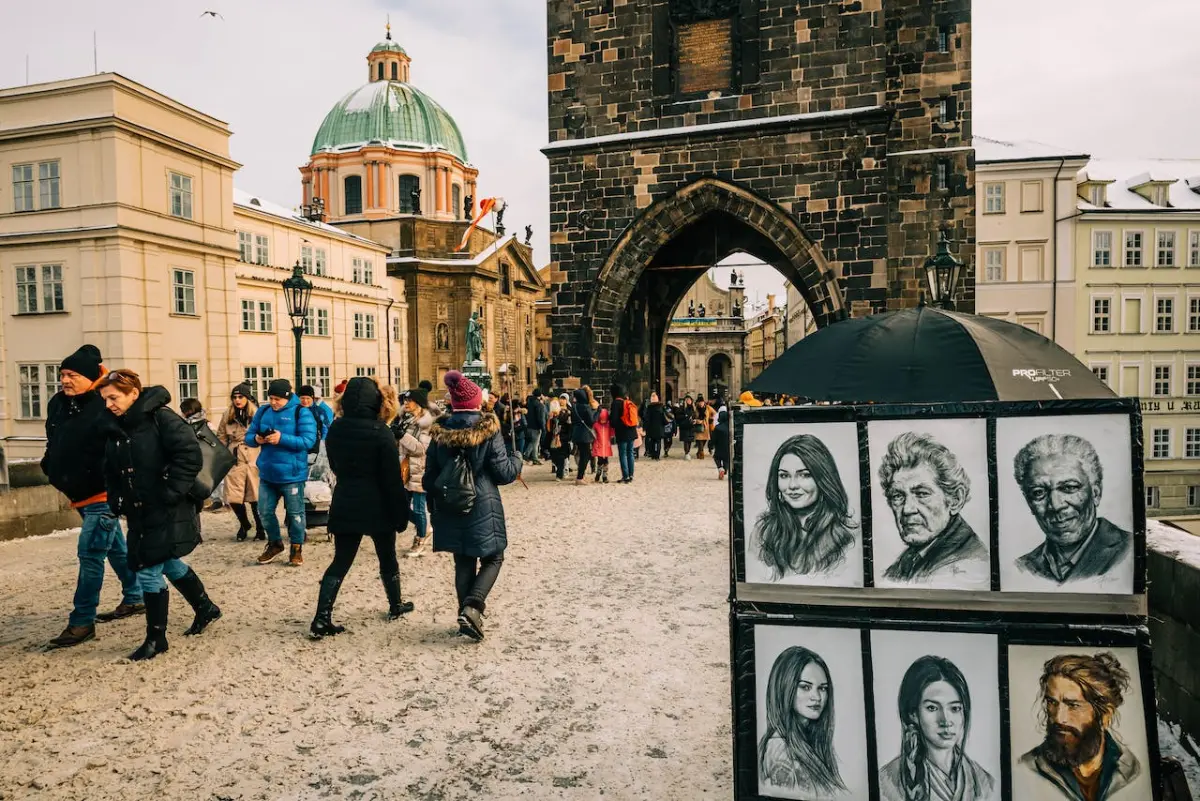
Amidst winter, tourists stroll past painted faces on Charles Bridge, ©Kováčová / Pexels
If you’re planning to visit the Charles Bridge, you should know a few things before you go. First and foremost, the bridge is open only to pedestrians, so you won’t have to worry about vehicular traffic.
To get to the bridge, you can take a tram or bus to Malá Strana, the neighbourhood on the opposite side of the river from the Old Town. From there, it’s just a short walk to the bridge. Alternatively, you can take public transport to the Old Town Square and walk to the bridge.
There is no entrance fee to cross the bridge, and it’s open 24 hours a day. However, remember that it can get quite crowded during peak tourist season, so you may want to plan your visit accordingly.
Walking across the bridge, you’ll be treated to stunning views of the Vltava River and the city skyline. Be sure to take your time and admire the many landmarks and statues along the way, including the Old Town Bridge Tower and the statue of St. John of Nepomuk.
One interesting fact about the Charles Bridge is that it was initially built as a wooden bridge in the 12th century but was later rebuilt in stone in the 14th century. Today, it remains one of the most iconic structures in Prague and a must-visit for any tourist.
Legends and Folklore
The Charles Bridge is steeped in legends and folklore, making it more than just a bridge. Here are a few of the most popular stories associated with the bridge:
- Legend of Bruncvík: According to one legend, the bridge was built with the help of a knight named Bruncvík. He had a magical sword that could cut through anything, and he used it to cut through the rocks blocking the river. In return, the king promised to give Bruncvík whatever he wanted. Bruncvík asked for the right to build a castle on a small island in the river. The king agreed, and Bruncvík built a castle on what is now known as Kampa Island.
- King Wenceslas IV: King Wenceslas IV was responsible for many statues adorning the bridge. He commissioned them to be made in honour of various saints and religious figures. However, he is also known for his interest in numerology and the occult. Some people believe he used the bridge as a giant calculator, using the numbers associated with the statues to make predictions.
- Palindrome: The Charles Bridge is also known for its unique design. It is a palindrome, which looks the same from both directions. This was intentional, as it was believed to bring balance and harmony to the city.
The legends and folklore of the Charles Bridge add to its charm and charisma. Whether you believe in these stories, they are essential to the bridge’s history and culture.
Significance and Role
Charles Bridge is one of the most significant landmarks in Prague, Czech Republic. It has played a crucial role in the city’s history, serving as a vital trade route connecting Europe’s eastern and western parts. The bridge was also dedicated to St. John of Nepomuk, the patron saint of Bohemia, adding to its cultural and religious importance.
During the Middle Ages, the bridge facilitated the transportation of goods, making it a vital commercial hub for merchants and traders. It was also an essential route for pilgrims travelling to the holy sites in the city. The bridge’s strategic location made it a crucial defence system, protecting the city from potential invaders.
Charles Bridge also served as a symbol of justice, as the bridge tower housed the law faculty of Charles University. Lawyers and judges often met here to discuss legal matters and hold court sessions. The bridge’s historical significance has made it a popular tourist attraction, drawing millions of visitors annually.
Today, Charles Bridge is a testament to Prague’s rich cultural heritage, architectural brilliance, and multifaceted importance in the city’s history. It remains a vital landmark, connecting the past with the present and serving as a reminder of the city’s illustrious past.
FAQs
How long did it take to build the Charles Bridge?
The construction of Charles Bridge started in 1357 and was completed in the early 15th century. It took over 50 years to build the bridge.
What is the legend of the Charles Bridge in Prague?
According to the legend, the first stone of the bridge was laid by Charles IV himself, who chose the date and time based on astrological predictions. The legend also says a sacrificial egg was placed in the bridge’s foundation to strengthen it.
Why is Charles Bridge famous?
Charles Bridge is famous for its stunning architecture, Baroque statues, and rich history. It is one of the most visited tourist attractions in Prague.
What is the tradition of the Charles Bridge?
The tradition of the Charles Bridge is to touch the St. John of Nepomuk statue on the bridge and make a wish. It is believed that touching the statue brings good luck and ensures a return to Prague.
Why are the statues on the Charles Bridge black?
The statues on the Charles Bridge were initially made of sandstone, which, over time, became blackened due to pollution and weathering. Many statues have been restored to their original colour in recent years.
What is the significance of the statues on the Charles Bridge?
The statues on the Charles Bridge depict various saints, historical figures, and religious scenes. They are considered some of the finest examples of Baroque art in Central Europe and are essential to the bridge’s cultural heritage.
Secure your ticket for an unforgettable augmented-reality experience now!









